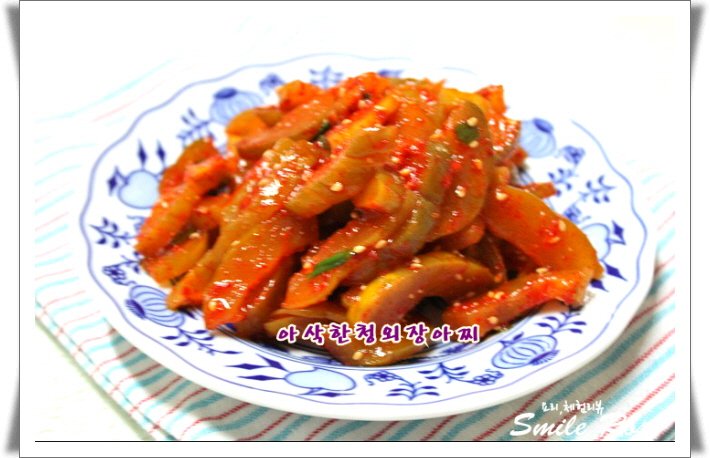Crispy Korean Melon Pickle Salad
A Delicious and Refreshing Salad Made with Preserved Korean Melon (Chamoe Jangajji)

Discover the delightful crunch and savory-sweet flavor of this Korean melon pickle salad! Made with homemade chamoe jangajji, this dish is a perfect side for any meal and a fantastic way to preserve the melon’s freshness. Enjoy this addictive appetizer that can last you until next year, bringing a burst of Korean flavor to your table.
Pickled Melon- Homemade Korean Melon Pickles (Chamoe Jangajji) 4 pieces
Salad Dressing Ingredients- Red Pepper Flakes (Gochugaru) 1 Tbsp
- Minced Garlic 1 Tbsp
- Oligosaccharide (or other liquid sweetener) 1 Tbsp (adjust to taste)
- Toasted Sesame Seeds 1 Tbsp
- Sesame Oil 1 Tbsp
- Red Pepper Flakes (Gochugaru) 1 Tbsp
- Minced Garlic 1 Tbsp
- Oligosaccharide (or other liquid sweetener) 1 Tbsp (adjust to taste)
- Toasted Sesame Seeds 1 Tbsp
- Sesame Oil 1 Tbsp
Cooking Instructions
Step 1
To make the pickles, first prepare fresh Korean melons. For a large batch, wash 10kg of young Korean melons (cheongoe) by soaking them in water mixed with 1 cup of baking soda and 1 cup of vinegar for about 30 minutes.

Step 2
After washing, drain the melons. Carefully scoop out the seeds from the center of each melon using a spoon. Removing the seeds is crucial for achieving a crisp texture in the pickles.

Step 3
Sprinkle salt evenly over the hollowed-out melons and let them cure for half a day (approximately 12 hours). This process draws out moisture, firming up the melon and enhancing its crispiness.

Step 4
Drain the salted melons and spread them out to dry in the sun for about a day until they become slightly leathery or ‘꾸들꾸들’ (kkudeul kkudeul). Once dried, layer them neatly into a storage container to make your jangajji.

Step 5
Prepare the pickling brine. Boil a mixture with a ratio of 1 part soy sauce (yangjo ganjang), 1 part traditional soy sauce (jip ganjang), 2 parts broth, and 2 parts plum extract (maesil cheong). Let it cool slightly before pouring over the melons. For the broth, you can use ingredients like dried kelp, anchovies, dried pollack heads, green onions, whole garlic cloves, onions, and shiitake mushroom stems.

Step 6
Observe the fermented pickles: those fermented for about 10 days will have a greenish hue, while those fermented for 20 days will turn a lovely yellowish-brown, indicating they are well-ripened and flavorful.

Step 7
For the salad, take about 4 pieces of your well-fermented Korean melon pickles and slice them into bite-sized pieces. If the pickles taste too salty, soak them in cold water for about 10 minutes to reduce the saltiness before proceeding.

Step 8
After squeezing out excess water from the soaked pickles, add the red pepper flakes (gochugaru) and gently mix (jomul jomul) to coat the pieces evenly with the spice. Be careful not to over-mix, as this can affect the texture.

Step 9
To the spiced pickles, add the toasted sesame seeds, chopped scallions, and sesame oil. Toss lightly one last time to combine everything beautifully. This is your finished Chamoe Jangajji Muchim! Each bite offers a delightful ‘ododok’ (crunchy) and ‘asak asak’ (crispy) sensation that makes it an irresistible side dish – a true ‘rice thief’! It’s delicious on its own, but even better with a bowl of warm rice and water. You can also try preserving some pickles by burying them in gochujang (red chili paste) or doenjang (soybean paste) for a different twist. This versatile banchan will be a favorite in your home from spring through summer next year! (A brief note about harvesting perilla seeds from the garden is included.)




